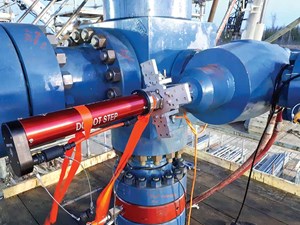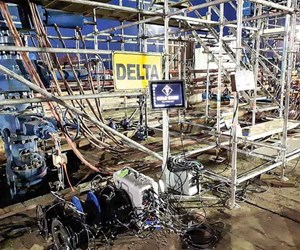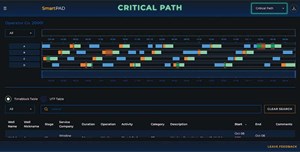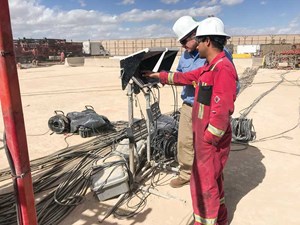Digital completion system integrates OFS data to increase fracing efficiency, lowering operational costs
This year’s tumultuous drop in crude oil prices is one of the worst in our industry’s history. Although WTI began the year in the $60/bbl range, the combination of a nasty price war between Saudi Arabia and Russia, the COVID-19-induced global demand crash, and a lack of storage capacity caused crude futures to plunge 300%, to minus $37.63/bbl in mid-April. Although prices have recovered since then, thanks in part to an agreement between Saudi Arabi and Russia plus rising demand in China, they remain too low to encourage drilling activity. Uncertainty regarding the pandemic and future demand, coupled with high global inventories and spare production capacity, put forecasts for WTI at approximately $40/bbl for the remainder of the year.
This combination of circumstances has caused a precipitous reduction in drilling activity in the U.S. and the Permian basin. Once the darling of the U.S. shale oil sector, leading the world in oil production growth for the last 12 years, Permian operators are now struggling with significantly reduced margins. Most all have slashed capex and reduced operations. Those still producing are looking to increase efficiencies by any means possible. With WTI hovering around the high $30s/bbl, most Permian companies are just covering their cash costs.
INEFFICIENCY CHALLENGE
Like in many other industries, including manufacturing, retail and food service, digital solutions are proving to be one answer. Replacing more expensive, time-consuming and dangerous manual operations, digital and automated technologies are changing the way that Permian operators extract crude from shale formations. With today’s tight market, digital solutions can lower break-even costs, so producers can make a profit with reduced commodity prices.
In completions, companies have traditionally manually tracked their operational time series data, using a company employee at the wellhead, who physically recorded the various service data, as they occurred. This process is inherently inefficient and imprecise. The operator’s data must then be reconciled against the service companies’ raw data, typically recorded and formatted differently, a further arduous and inexact exercise.
DIGITAL TRANSFORMATION
Cold Bore Technology’s SmartPAD is a digital completions technology that eliminates imprecise, manual tracking. Considered the world’s first universal completions operating system, SmartPAD has transformed fracing for producers in the Permian basin, the Bakken shale and in Western Canada, providing substantial increases in efficiencies, while providing a competitive advantage.
“We call it a centralized nervous system,” explains Cold Bore President Brett Chell. “The increased efficiencies are derived by connecting a bunch of different service companies’ automated equipment.” The SmartPAD system uses sensors installed on valves at the wellhead to measure pressure and valve position in six different locations, Fig. 1. The automated data are captured in real time by the system’s Industrial Internet of Things sensor-driven software. The result is the consolidation of all service company data, including coil, wireline, frac, pump-down, water and sand on one screen.

SmartPAD solves one of the most daunting challenges operators face today: how to track their operational time series data. “Our software does state detection on the frac trees,” Chell explains. “It replaces that company employee’s notebook with one-second digital data for the whole pad. The record of what happened at the wellhead is available, in a one-second digital format.” The system attaches all service data, via time stamp to the operational log, and auto-populates WellView and OpenWells. “The result is a fully autonomous system, visible and accessible to all, with completely formatted and time-stamped data all in one place.”
A permission-based edge server, installed on location, allows the data to be shared with all service companies, as well as remotely to the operator’s office, anywhere in the world, Fig. 2. Multiple frac locations can be monitored from a central location, with the potential to drastically reduce infrastructure requirements and spending.

Real time data capture advantage. The ability to capture the workflow in real time provides a better understanding of an operation’s critical path. Because the data is tracked to the second, the expected workplan can be compared to the actual workflow, reducing non-productive time (NPT), while enabling productivity efficiency gains (PEG) to be recorded, Fig. 3. “From the service side, one of the hardest things to track is when operations are optimized or performed faster than expected,” Chell explains. “With SmartPAD, PEGs are easily and precisely tracked.”
Once all the contextual service data are in one spot with workflow, Cold Bore’s frac analyzing tool comes into play. This software allows an operator to overlay any frac data set with another, and gain new insight. “Our software is driven by our clients,” Chell says. “It recognizes issues and suggests solutions. Eventually we will tie the software right into the equipment and allow it to make adjustments.” Use of the software also enables operators to move workers out of the most dangerous “hot zones,” greatly improving safety.

“SmartPAD gives an operator-centric perspective,” Chell continues. “It’s not as valuable to just see the coil data, for example. You want to know what it means in relation to the time series. What do all your raw values mean in relation to how long that took?” While the system optimizes field operations, it also optimizes office operations. The operational timestamp, i.e. the time series data pulled from the frac tree sensors, is non-biased and normalized, meaning that deliverables and missed targets, NPTs and PEGs are easily identified, and not subject to disagreement between the operator and service companies.
Automated contract function adds value. This allows for smart contracts between the operator and service companies, using a dual-handshake mechanism—the ability to agree on any credits or debits on the contract—which can be transacted down to the second. “You can have hundreds of little performance-based changes to the performance-based contract,” Chell explains. “And everything is non-biased and reconciled at the end of that job, before they’re done. So, when they leave, there’s no account managers, no comparing data sets, it’s all done and agreed to.”
Automated smart contracts also can be used as performance incentives. Because the contracts can be reconciled by the second, and transacted upon within a day, operators can choose to pay their “five star” service providers sooner than their “two star” providers. “It’s a self-incentivized payment plan,” Chell says, “based on the time series data. It puts the onus on the service companies to do better, if they want to turn their money faster.”
FIELD APPLICATIONS
Several Permian operators are currently using SmartPAD. Hibernia Resources had the system installed this year, and COO John Blevins III (PE) highlights the benefits of a remotely accessible system. “It allowed me the leniency and opportunity to run between our Houston and Midland offices, and be able to go and look back,” he says. “I could go in and open up a quick shot of the last six hours and see how the wells compared to each other. There was a lot of different things we could do, and my consultants were using it on location that way, too.”

Hibernia uses SmartPAD to study efficiencies on well swaps, a major issue for Permian operators aiming to reduce the time between fracs. “We were studying who had the most efficiencies, what was happening, and what we can learn from different crews,” Blevins explains. “We could diagnose the day-to-day, minute-to-minute and second-to-second things. Normally, we’re not capturing these small timeframes or operational inefficiencies that look like normal operations. With 390 stages, if I save three minutes, it’s a big chunk of change that can absolutely impact the bottom line.” Within a short time using SmartPAD, Hibernia was running its crews anywhere between an 11–12-minute swap, saving approximately 20 hours. “And there’s nobody beating us or doing it safer,” Blevins says.
One key driver of SmartPAD, Chell reiterates, is to reduce the time between fracs: “We increase stages per day drastically, because every time you reduce a segment of time between fracs, you add up to 20 little segments and you get a whole other stage of frac,” Fig. 4.
The ability to share the data, via the permission-based log in system, with everyone was very useful. “We were really open to sharing with everyone on location, because that’s the only way the team knows how good or bad they’re performing,” Blevins says. “Each morning, the different services can log in, on location or remotely, and see what they’re going to have to argue with me about. It was easy to sell to my guys at the wellhead, because it’s about getting efficient and getting us all off this location and on to the next one.”
SmartPAD allows an operator to compare whatever it wants: crew efficiency, service company efficiency, well swap efficiency, well-to-well efficiency, or pad-to-pad efficiency. “The key is that all of the data is formatted and in the context of the operation, itself,” Chell says. “So, once you have that, you can ask any analytic of the dataset, and all you have to do is build the visualization.”
Post-job efficiencies were also realized by Hibernia. “It’s invoicing versus time,” Blevins says. “SmartPAD provided an easy way to reconcile time in invoices. At the end of the day, we saved roughly $30,000, plus or minus, in that extra incremental time.”
Case study 2. At Parsley Energy, the push to gain efficiencies began five years ago. “The aim was to optimize resources,” says Agustin De Fex, senior manager for Completions. “Make it safer and better.”
Efficiencies and data were tracked manually by workers on location, using excel spreadsheets, relying on programming skills, and analyzing it on a case-by-case basis. While efficiencies started to be realized in the range of 25% to 30%, they came at an additional cost and required several months to understand them and optimize them, so the company would still achieve its goal of pumping at least 18 hr/day.
“Two years ago, we spoke with Cold Bore and realized we could get a more precise measure of time on location,” De Fex explains. “Suddenly you realize you can capitalize on one minute, two minutes, etc., because you have the granular data and can put it on a piece of paper. It’s a true measure of time.”
De Fex and his team identified 42 differentiated steps for frac, which can be measured minute by minute using live data. “We defined the critical path and steps and set an alarm to stay within the parameters to ensure we’re safe,” he says. “We saw incremental efficiency gains, which is crazy.”
These efficiencies were not gained at the price of safety, which is indeed paramount and requires its own separate budget. “It’s actually safer on location,” De Fex says. “Because now the company man is not focusing on recording every step and can remain focused on the work. We enhanced safety in our operations. It’s a gain-gain on both sides.”
Parsley expects its partnership with Cold Bore to continue into the long term. “Parsley is a young company, and we’re highly focused on the future state,” De Fex explains. “We look for partners who can adapt with us. With Cold Bore we were quickly able to gain efficiencies, which rendered their service cost-neutral. Soon after, we started saving money.”
SOLUTION GAINS TRACTION
Over the last year, Cold Bore has installed SmartPAD for a large number of North American fracing operators, from the Permian to B.C.’s Montney. “We’re continuing to see exceptional appetite for our technology,” says Chell. “With oil prices forecast to stay low for the rest of 2020, operators are striving for safer and more efficient production with less downtime. SmartPAD fits that bill.”
No one knows what the rest of 2020 holds, what may or may not occur to affect the price of oil. Wherever the price sits, Permian operators will need to employ best practices and technological solutions, in order to survive and thrive into 2021 and beyond. Cold Bore’s SmartPAD is one important tool they can use to do so.
- Digital transformation/Late-life optimization: Harnessing data-driven strategies for late-life optimization (March 2024)
- The reserves replacement dilemma: Can intelligent digital technologies fill the supply gap? (March 2024)
- Digital tool kit enhances real-time decision-making to improve drilling efficiency and performance (February 2024)
- When electric meets intelligence: Powering a new era in hydraulic fracturing (January 2024)
- Digital transformation: Digital twins help to make the invisible, visible in Indonesia’s energy industry (January 2024)
- Digital transformation: A breakthrough year for digitalization in the offshore sector (January 2024)
- Applying ultra-deep LWD resistivity technology successfully in a SAGD operation (May 2019)
- Adoption of wireless intelligent completions advances (May 2019)
- Majors double down as takeaway crunch eases (April 2019)
- What’s new in well logging and formation evaluation (April 2019)
- Qualification of a 20,000-psi subsea BOP: A collaborative approach (February 2019)
- ConocoPhillips’ Greg Leveille sees rapid trajectory of technical advancement continuing (February 2019)



